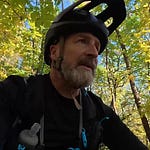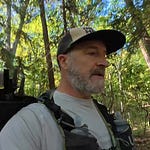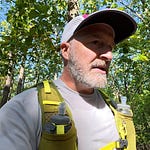The morning air felt like a gift – humidity in the 60s, temperature hovering in the low to mid-40s when the wind blew. Perfect conditions for what would be my final long run before the 50-miler. The goal: 50K minimum, with a stretch target of 60K for extra time on feet.
Car as Aid Station
I'd set my car as a makeshift aid station connecting two parks, creating a loop system where I could run 10K in one park, stop at my car, and then run 10K in the next, repeating as needed. The strategy was simple but effective: just water in the bottle, salt tabs to take every 10K, and something to eat at each car stop. Simplicity seemed right for today.
Green Everywhere
The opening mile clicked off at around 13:30 – a touch fast, perhaps, but I'd had three strong runs that week and felt rested. My watch showed a performance condition of negative one, which I've learned doesn't mean much on ultra-distance days. Sometimes when that number reads lower, the outcome ends up better.
Spring was in full effect. There was green everywhere. The trails had transformed from the greyness of winter. After all those hours spent in the bleakness of winter, seeing the landscape come alive felt energizing.
The first 5K passed in just over 40 minutes—not bad. The big hill climb loomed ahead, and I briefly considered grabbing my trekking poles but decided against it. For now, I'd tackle it without them.
Mental Note: Hunger Strikes Early
About an hour in, hunger hit. I hadn't brought anything to eat during this first loop – a tactical error. Set an alarm on the watch. Every 55 minutes. Reminder to eat.
Five miles into the first loop, I felt good enough to extend each 10K segment a bit longer, adding almost a mile per loop. Adding miles early would make the mental decision to go longer past 50K easier.
The second 5K came in a bit faster, just over 40 minutes. I hit the car for the first transition, grabbed fuel, three electrolyte caps, and was back on the trail.
The Math of Ultras
By the third 5K, I was doing the mental math. Forty-five minutes per 5K was my target pace. So far, I'd banked about 13 minutes ahead of schedule. Not a lot, but something.
The wind picked up, blowing pollen everywhere. I could feel it in my throat as I crossed 11 miles, still holding a 4.5 mph average. But I was beginning to question my fueling – three salt pills might have been too much. My stomach felt off.
Some climbs were pushing my heart rate into Zone 3 territory. I started power hiking the hills rather than running them. There was no sense in burning matches I didn't need to burn.
At 20K complete, the sobering thought hit: I still have 40K to go. The difference between a 50K and a 50-miler is indeed a big jump.
Ultramarathon Math: Realistic with a Bias Toward Pessimism
The fifth 5K segment ticked by in nearly 44 minutes—definitely slowing. At the 25K mark, I had about 15 minutes in the bank, which I'd need as fatigue accumulated. The good news: I was halfway to 50K. The bad news: I still had 25K remaining.
My buffer slowly eroded with each segment. By 30K, I'd slowed to a 4.4 mph average but was still ahead of my target pace.
From Fun to No Longer Fun
The 20-mile mark represented a clear threshold: we officially crossed from fun to no longer fun. Everything from this point would be a battle.
My speed had slowed to 4.3 mph. I found myself easily hitting Zone 3 heart rate, just power hiking the climbs. The salty residue on my skin told the story of hours of sweating. I wouldn't say I felt terrible, just... over it. My legs weren't feeling terrific, but what could I expect at 20 miles?
By 35K, my time bank had shrunk to about 10 minutes. With 25K still to go, I needed musical reinforcement. As if the universe knew, the first song played was Rage Against the Machine's "Bulls on Parade."
Trail Marathon: Check
I crossed the trail marathon mark about 15 minutes faster than two weeks prior – a positive sign. But despite my heart rate staying manageable, finding speed became increasingly difficult. The accumulation of fatigue was real.
I hit 50K in just under seven and a half hours, which was perfect timing since I was facing a long hill I didn't want to run. My pace had dropped to 4.1 mph, but the time on feet was what mattered – seven and a half hours and counting.
Interestingly, the 50K I'd completed the previous year had taken 10.5 hours, though with more elevation gain. Progress was evident.
The Mental Game of Loops
My strategy of repeating loops in two parks intentionally replicated the monotony of the upcoming race course – one loop repeated three times, another repeated twice. The mental training was as necessary as the physical.
By the 11th 5K segment, I'd slowed to nearly 54 minutes. My right knee was barking with IT band tightness, which I'd need to address in the coming week. But despite the fatigue, I focused on what waited at home: a date with a burger and a beer. Sometimes, motivation is that simple.
Looking Forward to Race Week
I crossed 60K at 9 hours and 14 minutes, with the final half-mile walk to the car bringing the day's total to over 37 miles at a 4.0 mph average.
Reflecting on the week's training, I realized I might need to adjust my taper. This past week included some serious intensity – 6×2-minute hard intervals on Friday at 8:15 pace, a threshold 5K on Wednesday, and a PR trail run on Monday. While it had been a solid week of running, saving my legs for the 50-miler might require lighter work during race week.
The thought of still having a half marathon to go beyond today's distance was sobering. That's what I signed up for.
Recovery First
For now, I was good on running. A few days off sounded perfect – maybe some easy bike rides, swimming, and a recovery run toward week's end. Though realistically, I knew I'd probably be back on my feet by Tuesday.
The immediate recovery plan was clear: shower, dinner, and then 90 minutes in the Normatec compression boots that had become key to my recovery routine. As far as I’m concerned, after water and food, a Normatec session is the way to go.
The day had been successful, but the nutrition strategy needed refinement. Water and electrolyte tabs worked well, but the timing and selection of fuel needed adjustment – I found myself genuinely hungry multiple times during the run.
A recovery drink with 20 grams of glutamine and some Bundaberg ginger beer waited in the car. My stomach wasn't bothering me, but it felt empty and worked over.
Thirty-seven plus miles complete. A long day on the trails done. Race day preparation at its finest.
Final Stats
Here's the breakdown for those keeping score:
Distance: 60.89K (37.83 miles)
Time: 09:14:50
Average Pace: 14:57/mile (or 4.0 mph)
Heart Rate: Avg [number] bpm
Elevation Gain: 5,066 feet
Heart Rate Zones:
Zone 1: 24% (02:21:19)
Zone 2: 68% (6:26:53)
Zone 3: 6% (0:35:22)
Training Effect: 5.0 aerobic
Training Status: Productive
Recovery Time: 72 hours
VO2 Max: Maintaining











